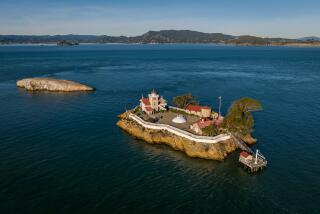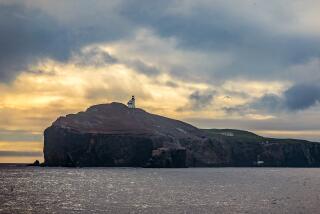Hugo Lingers on Carefree St. Croix
- Share via
ST. CROIX, U.S. Virgin Islands — A few of the palm-fringed beaches are a little short of palms, and piles of rubble remain here and there. But some reminders of the hurricane that almost swept the island off the map two years ago actually are pretty funny.
Hugo jokes, Hugo drinks, Hugo T-shirts and Hugo cafes greet tourists at every turn, and while there still is plenty of hammering going on, the predominant sound when I visited here in July was the whir of blenders turning out frothy tropical drinks.
Though it is party time again on St. Croix, the storm remains a sobering presence. You never sit long at one of the numerous waterfront bars without hearing another Hugo story.
Hurricane Hugo roared into St. Croix on the night of Sept. 17, 1989. It stalled for hours over the island, its 200-m.p.h. winds uprooting trees and grass, swamping boats, cutting off phones and power, and damaging 90% of the buildings--many severely enough to make three-quarters of the 55,000 residents homeless. For weeks, TV newscasts across America carried shots of the chaos and looting that followed--dealing an added blow to the island’s image as a carefree vacation paradise.
Despite a herculean cleanup effort--plus some terrific discounts during the current off-season, which runs through mid-December--tourism has remained way off, compounded by the recession and increased competition from other Caribbean islands.
This was my first visit to St. Croix, but I’d long heard about its appealingly eccentric charm. It’s said to have been Herman Wouk’s model for his novel “Don’t Stop the Carnival,” about a stressed-out New Yorker who buys a Caribbean hotel and discovers that island life can be a comedy of errors.
A couple on my plane who had moved to St. Croix from California did nothing but complain about island life while we waited at the immigration counter (staffers were on a break when our delayed plane finally arrived). Typically inconsiderate, they said.
But the wait actually was brief, as was the one I had while a cabdriver ran around looking for another passenger who could split the $10 fare into town. Pretty thoughtful, it seemed to me. And when I finally got up the nerve to rent a car (driving is on the left in the U.S. Virgin Islands, a carry-over from Danish rule and long abandoned by Denmark itself), I decided that St. Croix drivers were the most courteous I’ve encountered anywhere.
During my five days as a tourist here, I also found good food at the dozen or so restaurants I sampled; excellent prices on smart clothes and crafts, as well as on the usual high-ticket imports (the duty-free limit for returning U.S. citizens is $1,200); great snorkeling around Buck Island reef, and friendly, accommodating islanders who praised the spirit of camaraderie and sharing in the aftermath of the hurricane.
There is a certain comforting aspect about vacationing on a tropical island that is a U.S. possession (dozens of cable TV stations and automatic cash machines, for openers), but St. Croix often charmed me with its lack of sophistication as well. A sign in front of one store advertised “Sidewalk Sale Inside,” and the local newspapers were filled with nosy details that rarely see print at home. Hugo still often dominates the letters pages, blamed for everything from kids’ low math scores to unemployment.
I was glad I’d decided to stay in the island’s main town, Christiansted, because it has far more diversions for tourists than smaller Fredericksted, on the other end of the island.
The King’s Alley Hotel, which I had picked pretty much at random, was laid-back but modern, with no signs of hurricane damage. A surprise bonus was a panoramic harbor view from my room, No. 309 (and presumably from its second-floor counterpart as well). I also assume that I got one of the two best rooms with only about a week’s notice because occupancy was so low. The King’s Alley Cafe remains a much-lamented Hugo casualty, and the hotel’s poolside bar didn’t seem to be doing as big a business as some neighboring watering holes.
Most of these are connected to open-air dining rooms at the half a dozen or so other harbor-front hotels. Tourists quickly become regulars at the dusk ritual of swapping daily gossip while sipping a “sundowner” or two.
The best alfresco meals I had were at the Comanche Club, Tivoli Gardens, the Banana Bay Club and Stixx Hurricane Restaurant. The new Tutto Bene a couple of streets back from the water proved to be a wonderful choice for Italian food, if without a view. Try harbor-side Antoine’s at least once just for the menu, which includes several fascinating pages of color photos taken the day after the hurricane.
Christiansted’s old fort and stucco buildings with Mediterranean-style porticoes make it look like some ancient European town, so the sight of debris and crumbling walls somehow didn’t seem unusual. In Fredericksted, the hurricane detritus seemed more obvious, perhaps since more of the buildings are wood. A new restaurant called Le St. Tropez on King Street was an oasis amid a buzz of construction work. A few waterfront shops selling imported china and glassware seemed out of place and forlorn, waiting for cruise business that seldom comes these days because of the greater lure of nearby St. Thomas, the Caribbean’s No. 1 cruise stop.
Around the island, as in town, some businesses still are shuttered, but others are struggling to reopen--including the Tamarind Beach and the huge Divi Hotel (whose sign currently decorates Hugo’s Hurricane Cafe). The former Cathy’s Fancy is coming back as the Hibiscus Beach in December, and the recently closed Carambola Beach is expected to be rescued eventually, too. Classy new ones such as Villa Madeleine have appeared, and only a few hotels seem to have disappeared forever.
The main drawback to staying in Christiansted is that its only beach is at the Hotel on the Cay out in the harbor. Anyone can use it (it’s a three-minute, $3 round-trip ferry ride from the town dock), but there are better beaches elsewhere on the island, some at major hotels. St. Croix’s best beach is on Buck Island, about half an hour from Christiansted by boat. Several companies run half- or full-day excursions for $20 to $35 that include snorkeling along the marked trail of an underwater national park. Scuba trips also are popular, and lessons are available for those not certified. The usual water sports and fishing charters are available at numerous places.
At night there are plenty of entertainment opportunities in Christiansted (you will be drawn to Calabash at least once by the booming rooftop band) and at nearby resorts such as the Buccaneer and the Cormorant Beach Club.
As for sightseeing, a drive around the 82-square-mile island might include a stop at 17th-Century Whim Hall Plantation and Museum near Fredericksted, then a detour through the dense rain forest that makes the western part of the island so dramatically different from the arid east end. You will pass the Salt River, where Columbus landed (he’s also credited with naming the island Santa Cruz and with coining the term Virgin Islands). The island’s botanical garden reportedly remains a shadow of its former self, but it is making rapid headway in the hot, humid climate.
In fact, the only action some tourists sought on St. Croix was lying back and watching the flowers grow.
GUIDEBOOK
St. Croix, U.S. Virgin Islands
Getting there: Pan Am, American, Continental, TWA and Delta (beginning Dec. 15) offer direct air service from Los Angeles to St. Croix, usually stopping in Miami or New York and St. Thomas. Fares start at about $750 round trip, with 30-day advance purchase. High-season fares go up to about $850-$900. American Eagle (800-474-4884) and Sunaire Express (809-778-9300) fly to St. Croix from San Juan (about $80 round trip) and St. Thomas (about $65).
Where to stay: King’s Alley Hotel, 57 King St., Christiansted, St. Croix, U.S. Virgin Islands 00822, telephone (800) 843-3574; double rooms, $84-$140. Villa Madeleine, Box 3109, Christiansted, (800) 548-4461; one bedroom suites, $320. The Buccaneer Hotel, Box 25200, Christiansted, (800) 223-1108; doubles, $184-325; seven-night packages, $2,094-$2,549, include all meals, unlimited golf, tennis, water sports. Cormorant Beach Hotel, 4126 LaGrande, Christiansted, (800) 548-4460; doubles, $260-$285. Hotel on the Cay, Box 4020, Christiansted, (800) 524-2035; doubles, $198.
Note: Rates listed are for winter high season, beginning in mid-December. Summer and fall rates are generally 15%-20% lower.
For more information: Contact the U.S. Virgin Islands Division of Tourism, 3460 Wilshire Blvd., Suite 412, Los Angeles 90010, (213) 739-0138.
More to Read
Sign up for The Wild
We’ll help you find the best places to hike, bike and run, as well as the perfect silent spots for meditation and yoga.
You may occasionally receive promotional content from the Los Angeles Times.






